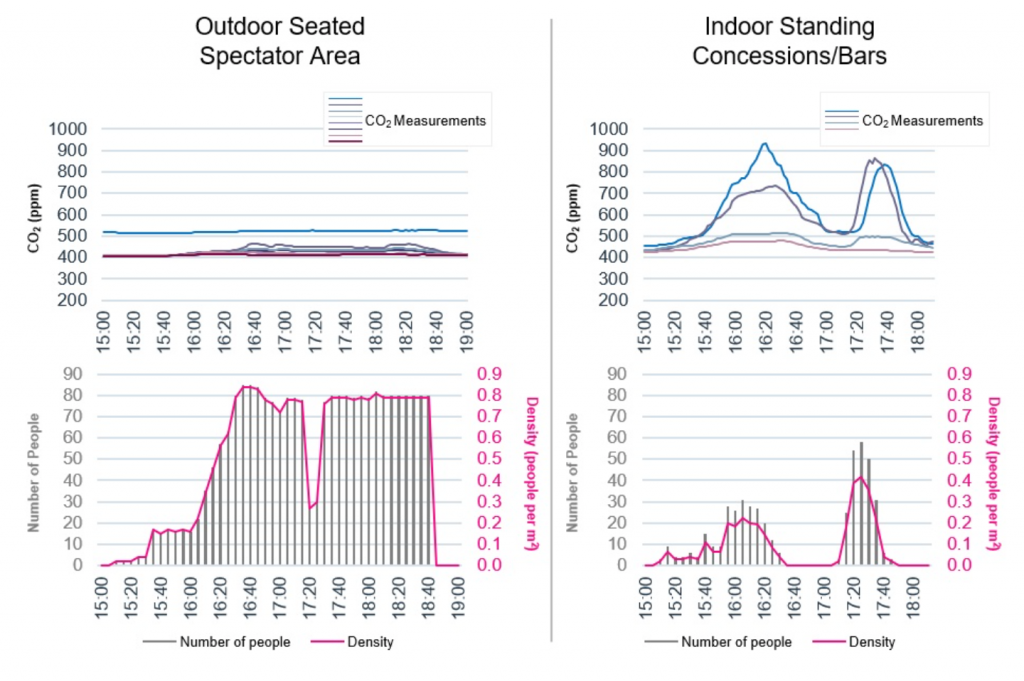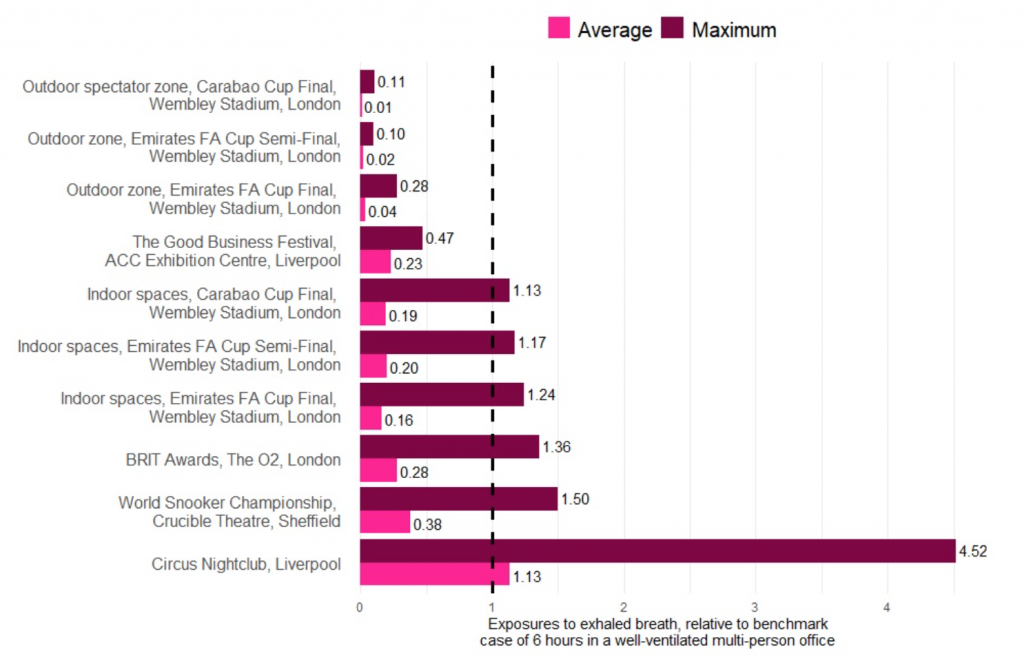The United Kingdom’s Events Research Program (ERP) surveyed several pilot events with varied Covid mitigation strategies. 58,000 people attended events, and 26,000 tests were given (12,000 before events and 14,000 after). In total, there were just 28 positives. So, what do these results mean for the return of live events, and what other data did this study reveal?
First, here’s the full results and scientific commentary that you can read for yourself. Now, let’s break down some of the key findings, beginning with a look at the nine pilot events.
Events
Each event tweaked its mitigation procedures slightly to give researchers an idea of what works best. ERP coordinators also tried to test as many attendees as possible. They instructed participants to take PCR tests on the day of the event and again 4-6 days after.
This table lays out the type of event, whether it was indoors or outdoors, where food and drink were served (if at all), whether masking or distancing were enforced, and how many positives came the day of the events vs. after the event.
| Event & setting | Attendance | Food/drink | Masks | Distancing | + Day-of | + After |
| Indoor snooker tournament | 10,417 | None | Yes | Phased out | 1 | 5 |
| Outdoor FA Cup semifinal | 2,728 | Indoors | Yes | Yes | 0 | 0 |
| Indoor Carabao Cup final | 7,737 | Indoors | Yes | Yes | 0 | 2 |
| Outdoor FA Cup final | 18,720 | Concourse | Yes | Yes | 6 | 0 |
| Outdoor business festival | 149 | Indoors | No | No | 0 | 0 |
| “First Dance” (indoor club) | 6,308* | Indoors | No | No | 3 | 7 |
| Outdoor concert | 6,101 | Outdoors | No | No | 1 | 1 |
| Indoor BRIT Awards | 3,132 | Indoors | No^ | No | 0 | 0 |
| Outdoor 5k run | 1,981 | None | No | No | 0 | 2 |
“The First Dance” event had the most positive tests of any event, and just 6-7% of attendees returned their test results.
Still, “Outbreak prevention controls … worked well and the event was preemptively flagged by the public health teams as having increased transmission risks,” the study says.
Other Points of Study
The U.K. government analyzed much more than just test results, though.
The researchers used testing, “wider public health data,” ventilation, CO2 levels, video analysis of crowd behavior, interviews, and surveys.
CO2 levels are a point of interest because when they increase, the risk of Covid transmission does, too.
“In any given indoor environment, when excess carbon dioxide levels double, the risk of transmission also roughly doubles,” says a study by the University of Colorado-Boulder.
Risk Assessments
Thus, outdoor spaces offer the lowest risk. However, low-ventilation areas like concession stands and restrooms pose higher risks outdoors.
Events that are indoors or have crowds moving around are more risky, though. And places like nightclubs that involve crowds moving around indoors present the greatest combination of risk factors.
The CO2 data tracked by the study helps to visualize these risks.
CO2 levels remain roughly constant in the open air, while they fluctuate with the number of people in enclosed spaces.
The study cautions, however, that increasing event capacity can lead to more people in poorly ventilated areas like restrooms and concession stand lines. That would lead to more CO2 – and, thus, increased risk of Covid transmission. So, event organizers could consider mitigation strategies like cashless concessions or concession delivery.
Additionally, the studies suggest that all but one event – the nightclub – presents less CO2 exposure than a six-hour workday in a properly ventilated shared office space.
IIFX U.K. affiliate Chris Kemp, a professor and leading expert on crowded space risk management, is studying these risks keenly. He is helping with the scale-up for the U.K.’s first “superscale full capacity event,” the British Grand Prix. The Formula One race is scheduled for July 18 with plans to welcome 145,000 fans. Such a large event could give key insight into what post-Covid live events will look like.
The Grand Prix venue has just built new luxury lodges near a main viewing area. Kemp says he is studying “the effect that this will have in relation to crowd migration, psychology and flow on the site.”
He is also working to implement “new ideas for changing flow, density and management strategies on site.”
Mitigation Practices
In addition to highlighting the risk of catching Covid at various live events, the study looks at mitigation practices.
The results above show that simply holding events outdoors or in well-ventilated areas reduces risk substantially.
The study also found that testing beforehand reduced risk of Covid transmission in a nightclub setting by 53%.
Moreover, social distancing and use of face coverings reduced risk by 41% and 13%, respectively. However, those measures are less practical given the singing, dancing, and drinking that happens in a club.
(The study does caution, though, that the nightclub used was especially set up for this pilot program in an indoor space with better ventilation than most nightclubs have.)
When asked to wear masks indoors, about 98% of those studied did, compared to 92% outdoors. Around 74% of people wore masks when moving around the event venue, and just shy of 60% wore masks while exiting events. Very few people used face coverings in hospitality areas where food and drinks were served, though.
Whatever mitigation measures an event takes, though, advance communication is key.
Using video footage for behavioral analysis, the study found the greatest perceived increase in compliance came as a result of pre-event communication and information posted online.
Prizes for taking and returning a Covid test and mailing Covid tests directly to participants resulted in the greatest increase in test uptake. The researchers also recommend testing closer to the time of the event and linking ticket purchases and test results so tickets are canceled if someone tests positive.
However, while increasing pre-event testing is an effective mitigation strategy, the study cautions that the U.K.’s current testing infrastructure is insufficient for mass-testing before a large number of events.
Therefore, the teams and organizations must focus on eliminating as much Covid risk as possible in the return to live events. (IIFX’s guide on the return of mass-spectator events is a great resource.)
What’s Next?
With the U.K. hopefully through the worst of the Covid pandemic, organizers of live events there must create an environment that meets the needs and desires of their constituents. These risk findings can help them do just that. This sweeping study also contains a wealth of survey data on consumer behavior in response to live event Covid mitigation policies. Check out our analysis of that data here.
Starting in August, some of our content will become subscriber-exclusive. This move will help us continue to grow and give our subscribers more insider advice, insights, and networking opportunities. Our newsletter, the IIFXtra, will send you a mix of free and exclusive content as soon as we publish it. Sign up for the IIFXtra below and learn more about subscribing here.
[mailmunch-form id=”1036259″]



